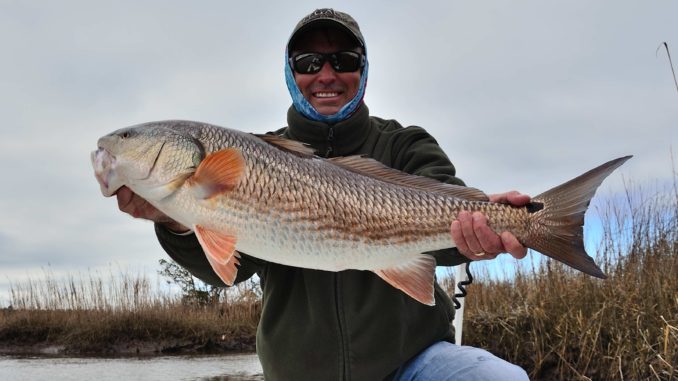
Huge winter schools will take flies, scented soft plastics through March
For most of the year, anglers comb South Carolina’s creeks, bays and shallow marshes for redfish, aka spot-tail bass.
But winter situations — like fish being in big schools — often make targeting reds almost like shooting fish in a barrel. March is the peak of the winter pattern, with water temperatures on the rise and feeding becoming a more normal, daily experience.
The shallow marshes around Winyah Bay near Georgetown, S.C., are prime places to hook feisty reds in the shallow backcountry on both low and high tides. That’s where Jordan Pate of Carolina Guide Service makes his living, knowing he needs to pinpoint several schools and stay with them from December to April.
“Our redfish gang up into large schools back in the creeks when the water gets cold,” said Pate (843-608-830). “Large groups of reds gather up in these shallow areas to forage for small shrimp, crabs and glass minnows.”
Pate typically ventures deep into small creeks off Winyah Bay, either near the Mother Norton area or between North Island, Debordieu and Hobcaw. These expansive marshes provide excellent habitat for redfish throughout the year and hold big schools of reds during the winter.
Pate prefers finding find a depression or a deeper section in the headwaters of the marsh. These waters heat up some during the winter and provide a refuge for minnows, shrimp and often, big schools of redfish.
“I like to find areas that have a large watershed that drains into one, single spot when the tide falls out. These pools will hold large schools of bait and reds at the same time,” he said.
While the most-opportune time to find congregated winter reds is at low tide, these fish can become hard to catch after a long winter of pressure, and Pate will start fishing these areas on higher water, too.
“The reds will remain in large schools, even on the high tide, and the water will be clearer. When you find them, you can usually get them to bite,” he said.
The big schools will stay together and patrol the marshes as units, and they feel much less pressure than when packed into a hole at low tide with only few escape routes available.
Most of Pate’s winter anglers use his custom-tied flies and a fly rod, but artificial shrimp and small, scented soft plastics, like Gulp! can also make these fish perk up when a feeding opportunity arrives.
Pate expects March to continue to produce big smiles and doubled-over rods until the spring thaw in the Georgetown region, aka the “spring breakup,” when the fish break into smaller groups and scattered into neighboring creeks.



Be the first to comment